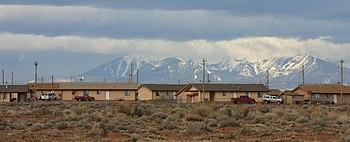Leupp, Arizona
| Leupp, Arizona | |
|---|---|
| CDP | |

Leupp, looking west to the San Francisco Peaks
|
|
 Location in Coconino County and the state of Arizona |
|
| Location in the United States | |
| Coordinates: 35°17′51″N 111°0′20″W / 35.29750°N 111.00556°WCoordinates: 35°17′51″N 111°0′20″W / 35.29750°N 111.00556°W | |
| Country | United States |
| State | Arizona |
| County | Coconino |
| Area | |
| • Total | 13.6 sq mi (35.1 km2) |
| • Land | 13.6 sq mi (35.1 km2) |
| • Water | 0.0 sq mi (0.0 km2) |
| Elevation | 4,763 ft (1,452 m) |
| Population (2010) | |
| • Total | 951 |
| • Density | 70/sq mi (27/km2) |
| Time zone | MST (UTC-7) |
| ZIP code | 86035 |
| Area code | 928 |
| FIPS code | 04-40630 |
| GNIS feature ID | 0024010 |
Leupp (Navajo: Tsiizizii) is a census-designated place (CDP) in Coconino County, Arizona, United States. The population was 951 at the 2010 census.
The Bureau of Indian Affairs established a school in Leupp in 1902. The town's name is pronounced LOOP. Soon afterward, the school was moved to a new location known as Old Leupp. Old Leupp is a few miles to the southeast of Leupp. Later in 1907, Leupp became the headquarters of the Leupp Indian Land. It was one of five Navajo Indian Lands that existed before 1936.
Navajo Code Talkers
In 1942, Philip Johnston, who was raised 12 miles North of Leupp as a young boy, proposed the idea of having the Navajo language be used as a code in World War II against the Japanese. The code which was unbreakable until the US government released the top secret files, helped U.S in the war. Its significances is that the Navajo language is so complex with its dialect and sentence structure that it would take 2 1/2 minutes to successfully translate and transmit and then re-translate the message, which would take hours for a regular soldier to complete. Had it not been for the surrounding communities like Leupp and Flagstaff, Johnson probably would have never been here to interact with the Navajo people and learn the language. Therefore, the Navajo code talkers would not have existed and would not be there to help US win the war.
During World War II, an abandoned Bureau of Indian Affairs boarding school in Leupp was used as the Leupp Isolation Center, for Japanese American internees considered to be "troublemakers" by camp authorities. The first inmates were transferred from Manzanar by way of Leupp's predecessor, the Moab Isolation Center. After a December 1942 clash between camp guards and several hundred Japanese American internees, in which two prisoners were killed, nine prisoners and one guard injured, the 16 men who had instigated the protests were removed from camp and placed in surrounding town jails. While they waited in jail (without being charged with a crime or allowed a hearing) War Relocation Authority officials converted a former Civilian Conservation Corps camp outside Moab, Utah into a temporary isolation center for "noncompliant" Japanese Americans. The 16 men from Manzanar arrived in Moab on January 11, 1943. Over the next three months, another 25 "troublemakers" — mostly men who had resisted the WRA's attempts to assess the loyalty of incarcerated Japanese Americans — were brought to Moab, and on April 27 most of the population was transferred to Leupp. (Five men, serving sentences in the nearby county jail after protesting conditions in the isolation center, were transported to Leupp in a five-by-six-foot box on the back of a truck. Their separate transportation was arranged by Moab director Francis Frederick, who had also handed down their sentences for "unlawful assembly.")
...
Wikipedia

